
|
Now it is bright as 6.3 mag (Sept. 19, Marco Goiato). It is expected to brighten up to 4-5 mag from autumn to winter. It keeps observable in excellent condition until autumn in the Southern Hemisphere. In the Northern Hemisphere, it keeps unobservable until late November.
Date(TT) R.A. (2000) Decl. Delta r Elong. m1 Best Time(A, h)
Sept.19 14 47.71 -45 44.0 1.446 1.326 62 6.1 19:27 ( 41,-11)
Sept.26 14 41.14 -41 23.8 1.544 1.236 53 5.9 19:16 ( 47,-12)
|
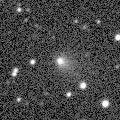
|
It brightened very rapidly. Now it is so bright as 10.4 mag (Sept. 24, Maik Meyer). It is observable at 10-12 mag until next spring in excellent condition in the Northern Hemisphere. It keeps unobservable in the Southern Hemisphere.
Date(TT) R.A. (2000) Decl. Delta r Elong. m1 Best Time(A, h)
Sept.19 3 14.66 78 9.3 1.986 2.308 95 10.8 3:27 (180, 47)
Sept.26 3 14.21 82 45.7 1.942 2.276 95 10.7 3:00 (180, 42)
|

|
Now it is very bright as 10.4 mag (Sept. 16, Marco Goiato). In the Northern Hemisphere, it keeps very low in the evening until mid December. It will be getting lower gradually after this even in the Southern Hemisphere.
Date(TT) R.A. (2000) Decl. Delta r Elong. m1 Best Time(A, h)
Sept.19 15 15.08 -15 29.9 1.949 1.601 55 11.0 19:27 ( 60, 14)
Sept.26 15 34.32 -16 58.3 1.972 1.586 53 11.0 19:16 ( 58, 13)
|

|
It brightened up to 3.7 mag and became a naked eye comet in mid January (Jan. 13, Marek Biely). Now it is fading. But it is bright as 11.3 mag still now (Sept. 20, Seiichi Yoshida). In the Northern Hemisphere, it keeps observable for a long time until the comet fades out. It will be unobservable soon in the Southern Hemisphere.
Date(TT) R.A. (2000) Decl. Delta r Elong. m1 Best Time(A, h)
Sept.19 16 2.69 37 29.9 3.556 3.332 69 11.2 19:27 (108, 51)
Sept.26 16 10.29 35 15.2 3.673 3.405 66 11.4 19:16 (105, 49)
|

|
It approached to the sun down to 0.3 a.u. on July 6, and brighted up to 3.9 mag (July 6, Thomas Lehmann). Now it is 12.1 mag (Sept. 22, Chris Wyatt). In the Northern Hemisphere, it keeps observable until the comet fades out. It will not be observable after this in the Northern Hemisphere.
Date(TT) R.A. (2000) Decl. Delta r Elong. m1 Best Time(A, h)
Sept.19 13 35.04 -42 51.3 2.126 1.689 51 11.9 19:27 ( 51,-20)
Sept.26 13 57.20 -45 3.6 2.275 1.805 50 12.3 19:16 ( 48,-20)
|
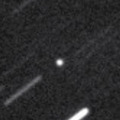
|
Now it is 14.3 mag (Sept. 6, Sandor Szabo). Finally it began to be visible visually. It will brighten very rapidly after this. It will brighten up to 11 mag from autumn to winter. But it keeps very low in the Northern Hemisphere. It will be getting lower gradually after this even in the Southern Hemisphere.
Date(TT) R.A. (2000) Decl. Delta r Elong. m1 Best Time(A, h)
Sept.19 15 51.63 -15 48.9 1.688 1.535 63 12.2 19:27 ( 53, 19)
Sept.26 16 9.68 -17 34.8 1.705 1.509 61 12.0 19:16 ( 51, 18)
|
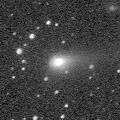
|
Now it is 11.1 mag (Sept. 21, Seiichi Yoshida). It keeps bright as 11-12 mag from August to October. In the Northern Hemisphere, it is getting higher gradually, and it keeps observable in good condition after this. In the Southern Hemisphere, it keeps low until November.
Date(TT) R.A. (2000) Decl. Delta r Elong. m1 Best Time(A, h)
Sept.19 8 48.73 21 37.8 1.787 1.323 46 12.1 4:20 (262, 28)
Sept.26 9 11.54 20 29.9 1.794 1.354 48 12.1 4:26 (265, 30)
|
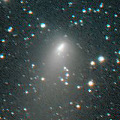
|
It brightened rapidly up to 10.4 mag from July to August (July 18, Maik Meyer). Now it is fading, but it is bright as 12.2 mag still now (Sept. 18, Carlos Labordena). It is observable in good condition in the Northern Hemisphere, but it will be unobservable soon in the Southern Hemisphere.
Date(TT) R.A. (2000) Decl. Delta r Elong. m1 Best Time(A, h)
Sept.19 18 48.75 44 36.8 1.234 1.724 100 12.2 19:27 (152, 79)
Sept.26 18 53.12 45 4.6 1.298 1.754 98 12.5 19:16 (145, 77)
|
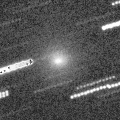
|
It brightened rapidly in mid August. Now it is very bright as 11.5 mag (Sept. 21, Michael Jager). Secondary component H is also visible as 15 mag (Sept. 21, Michael Jager). In the Northern Hemisphere, it keeps observable in good condition in the morning sky. It keeps locating extremely low from summer to autumn.
Date(TT) R.A. (2000) Decl. Delta r Elong. m1 Best Time(A, h)
Sept.19 8 56.76 15 1.9 1.262 0.869 43 12.6 4:20 (268, 23)
Sept.26 9 18.91 11 51.6 1.333 0.928 44 13.2 4:26 (272, 24)
|
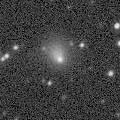
|
Now it is bright as 12.5 mag (Sept. 21, Seiichi Yoshida). It will pass close to the earth from spring to summer in 2016, and it is expected to be observable at 6-7 mag in good condition. In the Northern Hemispehre, it keeps observable in excellent condition until winter. In the Southern Hemisphere, it keeps very low until winter.
Date(TT) R.A. (2000) Decl. Delta r Elong. m1 Best Time(A, h)
Sept.19 5 41.52 39 18.7 3.002 3.153 89 12.9 4:20 (250, 71)
Sept.26 5 36.93 40 13.4 2.798 3.080 96 12.6 4:26 (240, 78)
|
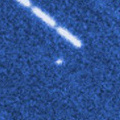
|
Now it is 12.5 mag (Sept. 13, Michael Jager). In the Northern Hemisphere, it is appearing in the morning sky. It keeps observable after this while the comet will be fading. It is not observable in the Southern Hemisphere until January when the comet will fade down to 16 mag.
Date(TT) R.A. (2000) Decl. Delta r Elong. m1 Best Time(A, h)
Sept.19 10 46.23 28 6.3 2.649 1.844 29 13.5 4:20 (242, 9)
Sept.26 11 4.61 27 11.8 2.666 1.893 32 13.7 4:26 (245, 11)
|
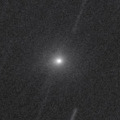
|
New bright comet. Now it is 11.6 mag (Aug. 18, Chris Wyatt). In the Southern Hemisphere, it keeps observable in the evening sky until the comet becomes fainter than 18 mag in winter. In the Northern Hemisphere, it will never be observable again.
Date(TT) R.A. (2000) Decl. Delta r Elong. m1 Best Time(A, h)
Sept.19 14 56.11 -44 55.1 1.311 1.241 63 13.5 19:27 ( 40,-10)
Sept.26 15 22.66 -49 40.7 1.437 1.341 63 14.1 19:16 ( 36,-11)
|

|
It brightened up to 12.9 mag in outburst on Sept. 22 (Jean-Francois Soulier).
Date(TT) R.A. (2000) Decl. Delta r Elong. m1 Best Time(A, h)
Sept.19 17 21.79 -29 22.6 5.990 6.007 86 13.7 19:27 ( 27, 20)
Sept.26 17 24.64 -29 14.8 6.098 6.005 79 13.8 19:16 ( 30, 19)
|

|
It is fading, but bright as 12.7 mag still now (Sept. 17, Uwe Pilz). It keeps observable in good condition until winter when the comet becomes fainter than 18 mag.
Date(TT) R.A. (2000) Decl. Delta r Elong. m1 Best Time(A, h)
Sept.19 2 53.42 12 38.4 1.355 2.150 130 13.8 3:05 ( 0, 68)
Sept.26 2 49.12 12 25.9 1.342 2.197 138 14.0 2:33 ( 0, 68)
|

|
Now it is 14.7 mag (Sept. 6, Sandor Szabo). In 2015, it keeps 13-14 mag and will be observable in good condition for a long time.
Date(TT) R.A. (2000) Decl. Delta r Elong. m1 Best Time(A, h)
Sept.19 19 15.99 -13 26.0 3.270 3.776 112 13.8 19:27 ( 1, 42)
Sept.26 19 19.58 -13 46.5 3.387 3.802 106 13.9 19:16 ( 5, 41)
|
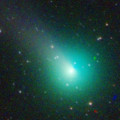
|
It brightened up to 6.0 mag in mid May (May 14, Chris Wyatt). Now it is fading. But it is bright as 12.5-13.0 mag still now (Sept. 12, Michael Jager). In the Northern Hemisphere, it keeps observable in good condition after this while the comet will be fading. It locates somewhat low in the Southern Hemisphere.
Date(TT) R.A. (2000) Decl. Delta r Elong. m1 Best Time(A, h)
Sept.19 8 42.10 19 38.6 2.681 2.140 47 13.9 4:20 (265, 29)
Sept.26 8 41.88 20 34.5 2.652 2.233 54 14.1 4:26 (269, 36)
|

|
Now it is 14.4 mag and visible visually (Sept. 6, Sandor Szabo). It keeps 13 mag for a long time from 2015 autumn to 2016 summer. In the Northern Hemispehre, it keeps observable in good condition for a long time. It keeps unobservable in the Southern Hemisphere.
Date(TT) R.A. (2000) Decl. Delta r Elong. m1 Best Time(A, h)
Sept.19 6 49.89 58 44.8 3.236 3.217 79 14.3 4:20 (215, 55)
Sept.26 7 1.65 61 17.7 3.113 3.178 84 14.2 4:26 (209, 56)
|
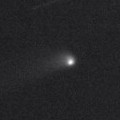
|
Now it is 15.6 mag (Sept. 13, Sandor Szabo). It will brighten up to 14 mag from 2015 to 2016. It keeps observable in good condition for a while.
Date(TT) R.A. (2000) Decl. Delta r Elong. m1 Best Time(A, h)
Sept.19 2 31.71 13 44.2 3.405 4.182 135 14.4 2:43 ( 0, 69)
Sept.26 2 21.05 14 7.8 3.325 4.184 144 14.3 2:05 ( 0, 69)
|

|
Now it is 14.1 mag and visible visually (Aug. 21, Uwe Pilz). Distant object, but it keeps observable at 14-15 mag for a long time from 2015 to 2016.
Date(TT) R.A. (2000) Decl. Delta r Elong. m1 Best Time(A, h)
Sept.19 21 10.53 -4 49.4 4.384 5.209 141 14.4 21:18 ( 0, 50)
Sept.26 21 9.80 -5 19.7 4.436 5.192 134 14.4 20:50 ( 0, 50)
|
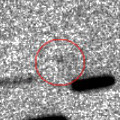
|
It was so faint as 20.0 mag in August (Aug. 17, Hidetaka Sato). However, it brightened by 6 mag in outburst in mid September. Now it is bright as 13.7 mag (Sept. 21, Seiichi Yoshida). It keeps observable in excellent condition for a while.
Date(TT) R.A. (2000) Decl. Delta r Elong. m1 Best Time(A, h)
Sept.19 4 46.61 8 26.0 1.503 1.998 103 14.4 4:20 (340, 62)
Sept.26 4 51.00 7 16.0 1.473 2.039 109 14.6 4:26 (356, 62)
|

|
First return of a periodic comet discovered in 1994. Now it is 15.4 mag (Aug. 27, Mitsunori Tsumura). It will brighten up to 15 mag from summer to autumn, and will be observable in excellent condition in the Southern Hemisphere. It locates somewhat low in the Northern Hemisphere.
Date(TT) R.A. (2000) Decl. Delta r Elong. m1 Best Time(A, h)
Sept.19 22 39.06 -34 25.4 1.582 2.467 144 14.9 22:47 ( 0, 21)
Sept.26 22 35.67 -33 26.6 1.612 2.460 139 14.9 22:16 ( 0, 22)
|
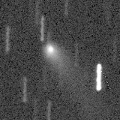
|
Now it is 14.9 mag (Aug. 26, D. Buczynski). It keeps 15 mag for a long time from 2014 to 2015. It is observable in excellent condition in the Northern Hemisphere. It locates low in the Southern Hemisphere.
Date(TT) R.A. (2000) Decl. Delta r Elong. m1 Best Time(A, h)
Sept.19 2 4.98 42 7.8 3.550 4.216 125 15.0 2:16 (180, 83)
Sept.26 1 57.82 43 21.8 3.513 4.240 131 15.0 1:42 (180, 82)
|

|
It is not observable now. It will be observable after mid October in the Northern Hemisphere, or after December in the Southern Hemisphere. It is expected to brighten up to 13 mag from winter to spring. It will be observable in excellent condition in the Southern Hemisphere. But it locates somewhat low in the Northern Hemisphere.
Date(TT) R.A. (2000) Decl. Delta r Elong. m1 Best Time(A, h)
Sept.19 10 53.77 9 1.6 3.289 2.329 14 15.3 4:20 (256, -4)
Sept.26 11 7.13 7 35.0 3.249 2.313 17 15.2 4:26 (260, -1)
|

|
Now it is 15.3 mag (Sept. 12, Sandor Szabo). It keeps observable at 15 mag in good condition for a while.
Date(TT) R.A. (2000) Decl. Delta r Elong. m1 Best Time(A, h)
Sept.19 2 33.21 8 43.6 1.272 2.116 136 15.3 2:44 ( 0, 64)
Sept.26 2 34.19 8 10.2 1.225 2.114 143 15.3 2:18 ( 0, 63)
|

|
Now it is 14.9 mag (Sept. 13, Sandor Szabo). It keeps 15-16 mag for a long time until 2016. It keeps observable in excellent condition in the Northern Hemisphere. It keeps unobservable in the Southern Hemisphere.
Date(TT) R.A. (2000) Decl. Delta r Elong. m1 Best Time(A, h)
Sept.19 5 33.72 59 4.6 5.093 5.187 89 15.7 4:20 (204, 62)
Sept.26 5 36.23 60 35.6 5.005 5.186 94 15.6 4:26 (195, 63)
|
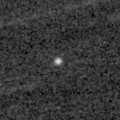
|
Now it is 17.1mag (Aug. 27, A. Maury, J.-G. Bosch, J.-F. Soulier, T. Noel). It is expected to brighten rapidly, and to be observable at 14.5 mag in good condition in autumn.
Date(TT) R.A. (2000) Decl. Delta r Elong. m1 Best Time(A, h)
Sept.19 4 3.38 -6 36.4 0.905 1.613 115 15.9 4:14 ( 0, 48)
Sept.26 4 16.71 -7 16.1 0.849 1.586 117 15.6 3:59 ( 0, 48)
|

|
It brightened up to 6.9 mag in 2014 autumn (Oct. 17, Marco Goiato). Now it is fading. It has already faded down to 16.2 mag (Aug. 22, K. Hills). In the Southern Hemisphere, it keeps observable in good condition until the comet fades out. In the Northern Hemisphere, it keeps observable until winter, but it locates somewhat low.
Date(TT) R.A. (2000) Decl. Delta r Elong. m1 Best Time(A, h)
Sept.19 23 27.00 -28 41.8 4.089 5.004 152 15.9 23:34 ( 0, 26)
Sept.26 23 18.11 -28 59.4 4.195 5.071 147 16.0 22:58 ( 0, 26)
|
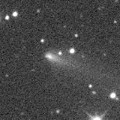
|
Now it is 15.1 mag (Sept. 13, Sandor Szabo). It keeps observable in good condition for a while. But it will be fading after this, and will be fainter than 18 mag in November.
Date(TT) R.A. (2000) Decl. Delta r Elong. m1 Best Time(A, h)
Sept.19 0 20.20 3 2.2 1.038 2.035 169 16.0 0:32 ( 0, 58)
Sept.26 0 15.25 2 13.2 1.064 2.066 177 16.1 23:55 ( 0, 57)
|

|
It brightened up to 13 mag in 2014. Now it is 15.2 mag (Sept. 12, Sandor Szabo). It will be fading slowly after this. It is observable at 16 mag in excellent condition from summer to winter in 2015.
Date(TT) R.A. (2000) Decl. Delta r Elong. m1 Best Time(A, h)
Sept.19 1 32.58 1 10.5 2.971 3.890 152 16.0 1:44 ( 0, 56)
Sept.26 1 28.68 0 49.7 2.948 3.906 160 16.0 1:13 ( 0, 56)
|
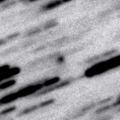
|
It brightened up to 16.4 mag in 2014 (Nov. 14, J. F. Hernandez). Now it is 17.2 mag (Aug. 27, D. Buczynski). It will be observable at 16 mag again from summer to autumn in 2015. However, it is fainter than this ephemeris recently.
Date(TT) R.A. (2000) Decl. Delta r Elong. m1 Best Time(A, h)
Sept.19 4 21.65 28 0.6 2.014 2.501 107 16.1 4:20 (338, 83)
Sept.26 4 24.61 28 14.8 1.958 2.527 113 16.1 4:08 ( 0, 83)
|

|
Now it is 15.1 mag (July 13, Yuji Ohshima). It is observable at 15-16 mag in good condition until autumn. It locates somewhat low in the Northern Hemisphere.
Date(TT) R.A. (2000) Decl. Delta r Elong. m1 Best Time(A, h)
Sept.19 17 35.00 -26 16.2 8.258 8.299 88 16.4 19:27 ( 25, 24)
Sept.26 17 34.54 -26 29.9 8.412 8.331 81 16.4 19:16 ( 29, 22)
|

|
No observations have been reported after November in 2014. Current brightness is uncertain. It must keep 16 mag for a long time from 2015 autumn to 2016 summer. It keeps observable in excellent condition in the Southern Hemisphere. It locates low in the Northern Hemisphere.
Date(TT) R.A. (2000) Decl. Delta r Elong. m1 Best Time(A, h)
Sept.19 2 43.05 -22 51.7 2.239 3.002 131 16.5 2:54 ( 0, 32)
Sept.26 2 27.38 -26 40.9 2.155 2.966 136 16.4 2:11 ( 0, 29)
|

|
No observations have been reported after November in 2014. It will brighten up to 11 mag from spring to summer in 2016. In the Northern Hemisphere, it keeps observable in good condition while the comet will be brightening. It locates somewhat low in the Southern Hemisphere.
Date(TT) R.A. (2000) Decl. Delta r Elong. m1 Best Time(A, h)
Sept.19 5 44.26 20 11.7 2.875 3.033 89 17.0 4:20 (299, 64)
Sept.26 5 49.98 20 8.2 2.740 2.994 94 16.8 4:26 (311, 69)
|

|
Now it is 18.3 mag (Aug. 18, Jean-Francois Soulier). It will be observable at 17 mag in good condition from summer to autumn.
Date(TT) R.A. (2000) Decl. Delta r Elong. m1 Best Time(A, h)
Sept.19 23 35.97 -6 56.2 1.477 2.479 174 17.0 23:43 ( 0, 48)
Sept.26 23 33.01 -7 30.1 1.487 2.476 167 16.9 23:13 ( 0, 48)
|

|
It has not been recovered yet. But it must be already bright as 17 mag. It will approach to the earth from autumn to winter, and it is expected to brighten up to 15 mag and observable in excellent condition.
Date(TT) R.A. (2000) Decl. Delta r Elong. m1 Best Time(A, h)
Sept.19 4 21.31 -7 7.2 1.247 1.857 110 17.2 4:20 (356, 48)
Sept.26 4 30.97 -7 1.3 1.169 1.825 114 17.0 4:14 ( 0, 48)
|

|
Now it is 15.5 mag (Sept. 6, Sandor Szabo). It is fading, but it is a bit brighter than this ephemeris. The fragments B and C are already fainter than 20 mag (June 12, Takaaki Oribe).
Date(TT) R.A. (2000) Decl. Delta r Elong. m1 Best Time(A, h)
Sept.19 23 0.20 2 55.4 5.458 6.444 168 17.0 23:07 ( 0, 58)
Sept.26 22 55.49 1 54.5 5.531 6.490 161 17.0 22:35 ( 0, 57)
|

|
Now it is 17.5 mag (July 25, Katsumi Yoshimoto). It has brightened in outburst up to 14 mag twice, in 2006 January and 2011 May. It is around the perihelion now. It keeps observable at 17 mag for a long time after this.
Date(TT) R.A. (2000) Decl. Delta r Elong. m1 Best Time(A, h)
Sept.19 23 13.42 -4 33.5 4.865 5.861 171 17.0 23:21 ( 0, 50)
Sept.26 23 11.02 -4 52.3 4.893 5.865 164 17.1 22:51 ( 0, 50)
|
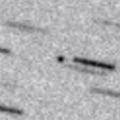
|
Now it is 16.3 mag (Aug. 22, E. Bryssinck). It is observable in good condition in the Northern Hemisphere. It is not observable in the Southern Hemisphere.
Date(TT) R.A. (2000) Decl. Delta r Elong. m1 Best Time(A, h)
Sept.19 8 17.68 38 40.3 1.699 1.474 59 17.2 4:20 (246, 41)
Sept.26 8 41.34 39 11.3 1.701 1.517 62 17.2 4:26 (246, 43)
|

|
Now it is 16.0 mag (Aug. 20, Catalina Sky Survey). It keeps observable in good condition until the comet fades out. In 2014, it must have been observable at 14 mag in good condition in the Southern Hemisphere.
Date(TT) R.A. (2000) Decl. Delta r Elong. m1 Best Time(A, h)
Sept.19 0 27.45 2 26.9 3.290 4.278 168 17.4 0:39 ( 0, 58)
Sept.26 0 22.41 2 29.4 3.329 4.330 176 17.5 0:07 ( 0, 58)
|

|
It will brighten up to 14 mag in 2016 summer. But it is not observable at the highlight. It keeps observable until March while the comet will be brightening gradually up to 15-16 mag.
Date(TT) R.A. (2000) Decl. Delta r Elong. m1 Best Time(A, h)
Sept.19 0 48.82 -2 36.2 1.824 2.802 163 17.6 1:00 ( 0, 53)
Sept.26 0 44.26 -3 30.8 1.779 2.772 170 17.4 0:28 ( 0, 52)
|
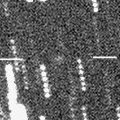
|
Now it is 18.8 mag (Aug. 10, A. Sodor, K. Sarneczky). It was predicted to be observable at 17.5 mag in good condition from autumn to winter, but it is a bit fainter actually.
Date(TT) R.A. (2000) Decl. Delta r Elong. m1 Best Time(A, h)
Sept.19 18 31.72 11 17.4 1.282 1.778 101 17.5 19:27 ( 26, 64)
Sept.26 18 41.18 7 56.3 1.295 1.747 98 17.5 19:16 ( 27, 60)
|
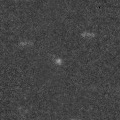
|
Now it is 17.1 mag (Aug. 23, E. Bryssinck). It was expected to brighten rapidly, and to be observable at 16 mag in good condition from summer to winter. But actually, it is much fainter than predicted.
Date(TT) R.A. (2000) Decl. Delta r Elong. m1 Best Time(A, h)
Sept.19 22 56.37 -12 2.2 1.303 2.287 164 17.7 23:03 ( 0, 43)
Sept.26 22 48.94 -11 19.6 1.300 2.256 156 17.6 22:29 ( 0, 44)
|
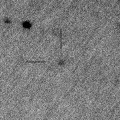
|
Now it is 18.9 mag (Aug. 25, S. Shurpakov). Now it is near the aphelion. It is observable at 17 mag in good condition from autumn to winter.
Date(TT) R.A. (2000) Decl. Delta r Elong. m1 Best Time(A, h)
Sept.19 3 55.36 16 36.1 3.825 4.350 115 17.7 4:06 ( 0, 72)
Sept.26 3 55.15 16 35.2 3.725 4.342 122 17.6 3:39 ( 0, 72)
|

|
First return of a periodic comet which brightened up to 8 mag in major outburst in 2010. It will be observable in excellent condition from winter to spring.
Date(TT) R.A. (2000) Decl. Delta r Elong. m1 Best Time(A, h)
Sept.19 7 5.55 31 16.4 2.224 2.133 71 18.2 4:20 (263, 53)
Sept.26 7 21.39 31 13.6 2.116 2.095 75 17.7 4:26 (265, 57)
|

|
First return of a periodic comet discovered in 2008. It approached to the earth and brightened up to 16 mag from spring to summer (June 2, WISE). Now it is fading. It has already faded down to 17.9 mag (Aug. 13, W. Hasubick).
Date(TT) R.A. (2000) Decl. Delta r Elong. m1 Best Time(A, h)
Sept.19 3 56.32 -10 10.2 0.807 1.546 116 17.7 4:07 ( 0, 45)
Sept.26 3 55.19 -10 57.5 0.817 1.598 122 17.9 3:38 ( 0, 44)
|

|
Now it is 17.8 mag (Aug. 19, A. Diepvens). It was observed at 17 mag in 2014 summer. In the Northern Hemisphere, it is observable at 17.5 mag in excellent condition also in 2015. It is not observable in the Southern Hemisphere.
Date(TT) R.A. (2000) Decl. Delta r Elong. m1 Best Time(A, h)
Sept.19 21 49.54 50 7.5 4.057 4.676 122 17.7 21:57 (180, 75)
Sept.26 21 47.80 48 45.7 4.082 4.709 123 17.8 21:28 (180, 76)
|

|
Now it is 16.5 mag (Aug. 8, J. Oey, P. Camilleri, H. Williams). It will be fading after this, and will be fainter than 18 mag in October.
Date(TT) R.A. (2000) Decl. Delta r Elong. m1 Best Time(A, h)
Sept.19 17 7.29 -22 12.5 3.293 3.312 82 17.8 19:27 ( 33, 25)
Sept.26 17 14.37 -22 8.6 3.400 3.323 77 17.9 19:16 ( 36, 24)
|

|
It will pass the perihelion in 2019. However, it has not been brightening since the discovery in 2010. Now it is 18.3 mag (Aug. 23, S. Shurpakov). It keeps observable in excellent condition from autumn to next spring in the Northern Hemisphere. It is not observable in the Southern Hemisphere.
Date(TT) R.A. (2000) Decl. Delta r Elong. m1 Best Time(A, h)
Sept.19 3 52.97 45 25.8 10.780 11.126 107 17.9 4:04 (180, 80)
Sept.26 3 51.87 45 49.6 10.658 11.101 113 17.9 3:35 (180, 79)
|
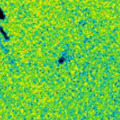
|
New comet. It is brightest now. It will be fading rapidly after October. It is observable in excellent condition in the SOuthern Hemisphere. But it will be unobservable soon in the Northern Hemisphere.
Date(TT) R.A. (2000) Decl. Delta r Elong. m1 Best Time(A, h)
Sept.19 0 14.69 -64 22.2 1.130 1.823 117 17.9 0:31 ( 0, -9)
Sept.26 22 37.46 -67 20.6 1.226 1.829 109 18.1 22:10 ( 0,-12)
|
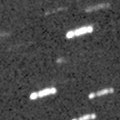
|
New comet. It will be observable at 17.5 mag in excellent condition in autumn.
Date(TT) R.A. (2000) Decl. Delta r Elong. m1 Best Time(A, h)
Sept.19 5 24.06 11 29.6 1.337 1.734 94 18.0 4:20 (320, 61)
Sept.26 5 36.79 9 26.2 1.287 1.738 98 17.9 4:26 (331, 62)
|

|
It was expected to brighten rapidly up to 15 mag in August. But actually, it is so faint as 19.7 mag, much fainter than predicted (Aug. 15, Slooh.com Canary Islands Observatory).
Date(TT) R.A. (2000) Decl. Delta r Elong. m1 Best Time(A, h)
Sept.19 20 3.42 0 4.7 0.223 1.147 124 19.0 20:16 ( 0, 55)
Sept.26 20 55.34 2 9.1 0.270 1.199 131 19.5 20:39 ( 0, 57)
|
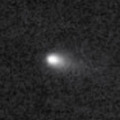
|
It brightened up to 15.9 mag in June as predicted (June 23, Ken-ichi Kadota). It was expected to be observable at 13 mag in good condition from summer to autumn. However, Jean-Gabriel Bosch detected the comet became disintegrating in July. Now it is so faint as 19.3 mag (Aug. 26, W. Hasubick). The fragment D and B are also observed as 19.0 mag (Sept. 20, Michael Jager) and 20.9 mag (Aug. 21, Pan-STARRS 1, Haleakala) respectively.
Date(TT) R.A. (2000) Decl. Delta r Elong. m1 Best Time(A, h)
Sept.19 2 25.04 3 15.9 0.847 1.738 139 21.8 2:36 ( 0, 58)
Sept.26 2 25.54 3 16.1 0.831 1.753 145 22.5 2:09 ( 0, 58)
|
|
![]()
 61P/Shajn-Schaldach
61P/Shajn-Schaldach C/2013 V4 ( Catalina )
C/2013 V4 ( Catalina ) 230P/LINEAR
230P/LINEAR C/2012 K1 ( PanSTARRS )
C/2012 K1 ( PanSTARRS ) 57P/du Toit-Neujmin-Delporte
57P/du Toit-Neujmin-Delporte 117P/Helin-Roman-Alu 1
117P/Helin-Roman-Alu 1 44P/Reinmuth 2
44P/Reinmuth 2 C/2010 S1 ( LINEAR )
C/2010 S1 ( LINEAR ) C/2014 W5 ( Lemmon-PanSTARRS )
C/2014 W5 ( Lemmon-PanSTARRS ) 81P/Wild 2
81P/Wild 2 151P/Helin
151P/Helin P/2003 WC7 ( LINEAR-Catalina )
P/2003 WC7 ( LINEAR-Catalina ) C/2011 J2 ( LINEAR )
C/2011 J2 ( LINEAR ) 174P/(60558) 2000 EC98 ( Echeclus )
174P/(60558) 2000 EC98 ( Echeclus ) 162P/Siding Spring
162P/Siding Spring C/2015 K1 ( MASTER )
C/2015 K1 ( MASTER ) 118P/Shoemaker-Levy 4
118P/Shoemaker-Levy 4 327P/2015 P2 ( Van Ness )
327P/2015 P2 ( Van Ness ) 50P/Arend
50P/Arend 74P/Smirnova-Chernykh
74P/Smirnova-Chernykh P/2010 V1 ( Ikeya-Murakami )
P/2010 V1 ( Ikeya-Murakami ) 319P/2015 G1 ( Catalina-McNaught )
319P/2015 G1 ( Catalina-McNaught ) C/2013 G3 ( PanSTARRS )
C/2013 G3 ( PanSTARRS ) 299P/2014 D2 ( Catalina-PanSTARRS )
299P/2014 D2 ( Catalina-PanSTARRS ) C/2010 U3 ( Boattini )
C/2010 U3 ( Boattini ) P/2015 Q2 ( Pimentel )
P/2015 Q2 ( Pimentel ) P/2015 Q1 ( Scotti )
P/2015 Q1 ( Scotti ) 320P/2015 HC10 ( McNaught )
320P/2015 HC10 ( McNaught ) 51P/Harrington
51P/Harrington![]()













































